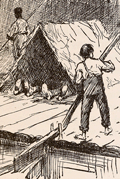|
MARK TWAIN'S "Tom Sawyer" is an interesting record of boyish adventure; but, amusing as it is, it may yet be fair to ask whether its most marked fault is not too strong adherence to conventional literary models? A glance at the book certainly does not confirm this opinion, but those who recall the precocious affection of Tom Sawyer, at the age when he is losing his first teeth, for a little girl whom he has seen once or twice, will confess that the modern novel exercises a very great influence. What is best in the book, what one remembers, is the light we get into the boy's heart. The romantic devotion to the little girl, the terrible adventures with murderers and in huge caves, have the air of concessions to jaded readers. But when Tom gives the cat Pain-Killer, is restless in church, and is recklessly and eternally deceiving his aunt, we are on firm ground--the author is doing sincere work. This later book, "Huckleberry Finn," has the great advantage of being written in autobiographical form. This secures a unity in the narration that is most valuable; every scene is given, not described; and the result is a vivid picture of Western life forty or fifty years ago. While "Tom Sawyer" is scarcely more than an apparently fortuitous collection of incidents, and its thread is one that has to do with murders, this story has a more intelligible plot. Huckleberry, its immortal hero, runs away from his worthless father, and floats down the Mississippi on a raft, in company with Jim, a runaway negro. This plot gives great opportunity for varying incidents. The travelers spend some time on an island; they outwit every one they meet; they acquire full knowledge of the hideous fringe of civilization that then adorned that valley; and the book is a most valuable record of an important part of our motley American civilization. What makes it valuable is the evident truthfulness of the narrative, and where this is lacking and its place is taken by ingenious invention, the book suffers. What is inimitable, however, is the reflection of the whole varied series of adventures in the mind of the young scapegrace of a hero. His undying fertility of invention, his courage, his manliness in every trial, are an incarnation of the better side of the ruffianism that is one result of the independence of Americans, just as hypocrisy is one result of the English respect for civilization. The total absence of morbidness in the book--for the mal du siecle has not yet reached Arkansas--gives it a genuine charm; and it is interesting to notice the art with which this is brought out. The best instance is perhaps to be found in the account of the feud between the Shepherdsons and the Grangerfords, which is described only as it would appear to a semi-civilized boy of fourteen, without the slightest condemnation or surprise,--either of which would be bad art,--and yet nothing more vivid can be imagined. That is the way that a story is best told, by telling it, and letting it go to the reader unaccompanied by sign-posts or directions how he shall understand it and profit by it. Life teaches its lessons by implication, not by didactic preaching; and literature is at its best when it is an imitation of life and not an excuse for instruction. As to the humor of Mark Twain, it is scarcely necessary to speak. It lends vividness to every page. The little touch in "Tom Sawyer," page 105, where after the murder of which Tom was an eye-witness, it seemed "that his school-mates would never get done holding inquests on dead cats and thus keeping the trouble present to his mind," and that in the account of the spidery six-armed girl of Emmeline's picture in "Huckleberry Finn," are in the author's happiest vein. Another admirable instance is to be seen in Huckleberry Finn's mixed feelings about rescuing Jim, the negro, from slavery. His perverted views regarding the unholiness of his actions are most instructive and amusing. It is possible to feel, however, that the fun in the long account of Tom Sawyer's artificial imitation of escapes from prison is somewhat forced; everywhere simplicity is a good rule, and while the account of the Southern vendetta is a masterpiece, the caricature of books of adventure leaves us cold. In one we have a bit of life; in the other Mark Twain is demolishing something that has no place in the book. Yet the story is capital reading, and the reason of its great superiority to "Tom Sawyer" is that is it, for the most part, a consistent whole. If Mark Twain would follow his hero through manhood, he would condense a side of American life that, in a few years, will have to be delved out of newspapers, government reports, county histories, and misleading traditions by unsympathetic sociologists. |

